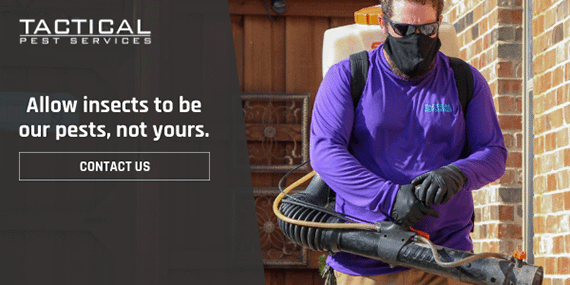As the sun begins to shine brighter and flowers bloom, spring brings a fresh sense of renewal to the world around us. However, for many, it also signals the beginning of allergy season. The warmer weather and increased plant life usher in pollen, which can trigger symptoms like sneezing, itchy eyes, and congestion. What many don’t realize, though, is that spring allergies aren’t just caused by pollen — pests can also play a significant role in exacerbating these symptoms. From dust mites to rodents, certain pests can aggravate allergy symptoms, making it crucial to understand the connection between pests and seasonal allergies.
In this article, we will explore how spring allergies and pests are interconnected, the types of pests that can contribute to allergy flare-ups, and most importantly, how you can take proactive measures to protect yourself and your home. Additionally, we will discuss how Tactical Pest Services can help reduce your exposure to these pesky allergy triggers.
The Spring Allergy Season: What’s Really Triggering the Symptoms?
Spring allergies, also known as hay fever or allergic rhinitis, occur when the immune system overreacts to allergens like pollen. Trees, grass, and flowers release pollen into the air, which is then inhaled or comes into contact with the skin. This triggers a response from the immune system, leading to symptoms like sneezing, a runny nose, itchy eyes, and even fatigue.
While pollen is the primary culprit, other environmental factors — such as indoor allergens like dust and mold — can also play a significant role in allergy symptoms. This is where pests come into play. Many common household pests, including rodents, cockroaches, and dust mites, produce allergens that can worsen your springtime symptoms.
How Pests Contribute to Allergy Symptoms
You might be wondering, “How exactly do pests affect allergies?” Pests, particularly those that are active during the spring months, leave behind waste products, saliva, and shed body parts that can become airborne allergens. These particles can easily be inhaled or come into contact with your skin, triggering allergic reactions. Here are some of the main pests that can contribute to your spring allergies:
1. Dust Mites
Dust mites are microscopic creatures that thrive in warm, humid environments, making spring an ideal time for them to multiply. They live in dust found in carpets, bedding, upholstery, and other fabrics. Dust mites feed on organic matter, like dead skin cells that humans shed. Their waste products and body parts are potent allergens, often causing allergic reactions in sensitive individuals. The proteins in dust mite waste can trigger sneezing, runny noses, and itchy eyes, making them a significant contributor to spring allergies.
Prevention Tips:
- Use allergen-proof covers on pillows and mattresses.
- Wash bedding in hot water regularly to kill dust mites.
- Vacuum frequently using a vacuum cleaner equipped with a HEPA filter.
- Maintain low humidity in your home by using a dehumidifier.
2. Cockroaches
Cockroaches are notorious for carrying allergens in their saliva, feces, and body parts. These pests are active year-round but may be more of a problem in the spring when they seek out food and water sources. Cockroach allergens are especially problematic for people with asthma, as they can cause severe respiratory symptoms. In fact, exposure to cockroach allergens has been linked to increased asthma attacks in both children and adults.
Prevention Tips:
- Eliminate any food and water sources that may attract cockroaches.
- Seal cracks and crevices around windows, doors, and pipes where cockroaches might enter.
- Keep your kitchen and bathroom clean, removing crumbs and food scraps immediately.
- Use cockroach baits or traps to reduce their numbers.
3. Rodents
Rodents, including mice and rats, are more likely to enter your home in the spring as they search for food, water, and shelter. Rodent droppings, urine, and saliva can all contribute to allergy flare-ups. Furthermore, rodents often carry diseases and parasites, which can lead to more severe health issues. Exposure to rodents, particularly their waste, can trigger symptoms like coughing, sneezing, and wheezing, and can exacerbate asthma in individuals with respiratory sensitivities.
Prevention Tips:
- Seal gaps and holes in walls, windows, and doors where rodents can enter.
- Keep food in sealed containers and avoid leaving pet food out overnight.
- Regularly dispose of trash in sealed containers and clean up any rodent droppings immediately.
- Consider setting traps or contacting pest control for assistance.
4. Termites
While termites are best known for their ability to damage wood structures, they can also be an allergy trigger for some individuals. Termites release dust-like particles when they infest wood, and these particles can become airborne, causing allergic reactions. Although they are less common in contributing to allergy flare-ups compared to other pests, termites can still be problematic if left unchecked.
Prevention Tips:
- Inspect your home for signs of termites, such as mud tubes or wood damage.
- Maintain proper ventilation and drainage around your home to prevent moisture buildup, which attracts termites.
- Consider using termite barriers or treatments to prevent infestations.
5. Wasps and Bees
While they are not directly linked to allergies in the same way that dust mites or cockroaches are, wasps and bees can still play a role in springtime allergy flare-ups. For people with insect sting allergies, the presence of wasps and bees near their home can cause severe allergic reactions. Even if you’re not allergic to their stings, their presence can contribute to anxiety and stress, which can exacerbate allergy symptoms.
Prevention Tips:
- Inspect your home for nests in eaves, attics, or trees.
- Remove nests early in the season to prevent them from growing larger.
- If you are allergic to stings, always carry an epinephrine auto-injector (EpiPen) and seek immediate medical attention if stung.
The Connection Between Pollen and Pests
Interestingly, both pollen and pests are more active during spring due to the warmer temperatures and the abundance of food sources. Pollen-producing plants tend to release their pollen in the spring, which coincides with the rise in pest activity. Pollen can trigger allergies on its own, but the presence of pests that contribute to other indoor allergens can compound the problem. For example, dust mites thrive in warm, humid conditions, which are often present in homes during allergy season. Cockroaches and rodents are also more likely to seek shelter indoors as the weather warms up, increasing the risk of exposure to their allergens.
How to Minimize the Impact of Spring Allergies and Pests
To manage your allergies effectively, it’s important to take steps to reduce your exposure to both pollen and pests. Here are some practical tips for minimizing the impact of spring allergies:
- Keep windows closed during high pollen days to prevent outdoor allergens from entering your home.
- Install air purifiers with HEPA filters to reduce allergens in the air.
- Use natural pest repellents like essential oils (peppermint, eucalyptus, or citronella) to deter pests like rodents and insects.
- Schedule a professional pest inspection to ensure your home is free from common allergy-triggering pests.
How Tactical Pest Services Can Help
If you’re struggling with both spring allergies and pests, you don’t have to deal with it alone. Tactical Pest Services offers expert pest control solutions that not only target common pests like rodents, cockroaches, and termites, but also help prevent allergens from taking over your home. Our trained technicians are equipped with the knowledge and tools to identify and eliminate pest infestations, reduce allergen exposure, and ensure your home remains a safe, healthy environment for you and your family.
By choosing Tactical Pest Services, you’re taking the first step toward a pest-free home that minimizes allergy triggers. Our comprehensive pest control services include inspections, treatments, and prevention strategies tailored to your unique needs.
Contact Tactical Pest Services Today
Spring allergies don’t have to take over your life. By addressing both pollen and pests, you can breathe easier and enjoy the season without worrying about allergy flare-ups. Contact Tactical Pest Services today to schedule your pest inspection and take action to protect your home from the pests that can aggravate your allergies. Let us help you spring into action and create a healthier living environment!


